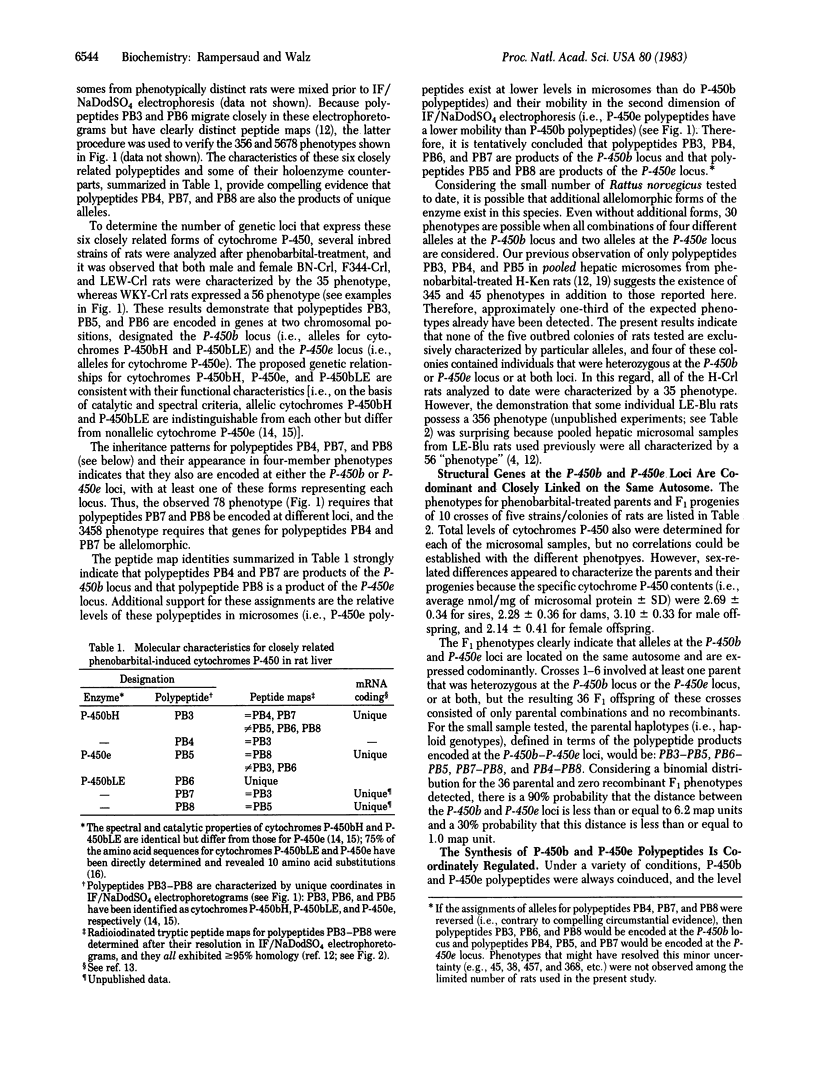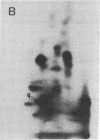Abstract
A subpopulation of phenobarbital-induced cytochrome P-450 in rat liver has been shown to consist of four closely related forms of the enzyme that appeared to be strain-related. In the present study, polypeptides composing this family were analyzed by two-dimensional electrophoresis of hepatic microsomes from 64 individual phenobarbital-treated rats. The animals surveyed included both sexes from four inbred and five outbred strains/colonies and F1 progenies from 10 crosses. Two new members of this polypeptide family were identified on the basis of their unique electrophoretic behavior and peptide maps. Eight phenotypes were observed that consisted of two to four member polypeptides. The six closely related cytochromes P-450 were found to be encoded at two genetic loci with at least four alleles at the P-450b locus and at least two alleles at the P-450e locus. Most colonies of outbred strains were characterized by polymorphism at one or both of these loci, and in no case did they contain unique alleles. Analyses of parents and their F1 progenies indicated that the P-450b and P-450e loci are closely linked on the same autosome and are expressed codominantly. Furthermore, the products of these loci appear to be coordinately regulated. The extreme homology between P-450b and P-450e genes, their high degree of polymorphism, and their close linkage suggest that they are subject to the same genetic mechanisms that maintain these features in other multigene families.
Full text
PDF




Images in this article
Selected References
These references are in PubMed. This may not be the complete list of references from this article.
- Adesnik M., Bar-Nun S., Maschio F., Zunich M., Lippman A., Bard E. Mechanism of induction of cytochrome P-450 by phenobarbital. J Biol Chem. 1981 Oct 25;256(20):10340–10345. [PubMed] [Google Scholar]
- Agosin M., Morello A., White R., Repetto Y., Pedemonte J. Multiple forms of noninduced rat liver cytochrome P-450. Metabolism of 1-(4'-ethylphenoxy)-3,7-dimethyl-6,7-epoxy-trans-2-octene by reconstituted preparations. J Biol Chem. 1979 Oct 10;254(19):9915–9920. [PubMed] [Google Scholar]
- Cheng K. C., Schenkman J. B. Purification and characterization of two constitutive forms of rat liver microsomal cytochrome P-450. J Biol Chem. 1982 Mar 10;257(5):2378–2385. [PubMed] [Google Scholar]
- Conney A. H. Pharmacological implications of microsomal enzyme induction. Pharmacol Rev. 1967 Sep;19(3):317–366. [PubMed] [Google Scholar]
- Dannan G. A., Guengerich F. P., Kaminsky L. S., Aust S. D. Regulation of cytochrome P-450. Immunochemical quantitation of eight isozymes in liver microsomes of rats treated with polybrominated biphenyl congeners. J Biol Chem. 1983 Jan 25;258(2):1282–1288. [PubMed] [Google Scholar]
- Dieter H. H., Johnson E. F. Functional and structural polymorphism of rabbit microsomal cytochrome P-450 form 3b. J Biol Chem. 1982 Aug 25;257(16):9315–9323. [PubMed] [Google Scholar]
- Dover G. Molecular drive: a cohesive mode of species evolution. Nature. 1982 Sep 9;299(5879):111–117. doi: 10.1038/299111a0. [DOI] [PubMed] [Google Scholar]
- Elshourbagy N. A., Guzelian P. S. Separation, purification, and characterization of a novel form of hepatic cytochrome P-450 from rats treated with pregnenolone-16 alpha-carbonitrile. J Biol Chem. 1980 Feb 25;255(4):1279–1285. [PubMed] [Google Scholar]
- Fujii-Kuriyama Y., Mizukami Y., Kawajiri K., Sogawa K., Muramatsu M. Primary structure of a cytochrome P-450: coding nucleotide sequence of phenobarbital-inducible cytochrome P-450 cDNA from rat liver. Proc Natl Acad Sci U S A. 1982 May;79(9):2793–2797. doi: 10.1073/pnas.79.9.2793. [DOI] [PMC free article] [PubMed] [Google Scholar]
- Fujii-Kuriyama Y., Taniguchi T., Mizukami Y., Sakai M., Tashiro Y., Muramatsu M. Construction and identification of a hybrid plasmid containing DNA sequence complementary to phenobarbital-inducible cytochrome P-450 messenger RNA from rat liver. J Biochem. 1981 Jun;89(6):1869–1879. doi: 10.1093/oxfordjournals.jbchem.a133389. [DOI] [PubMed] [Google Scholar]
- Gonzalez F. J., Kasper C. B. Cloning of DNA complementary to rat liver NADPH-cytochrome c (P-450) oxidoreductase and cytochrome P-450b mRNAs. Evidence that phenobarbital augments transcription of specific genes. J Biol Chem. 1982 May 25;257(10):5962–5968. [PubMed] [Google Scholar]
- Guengerich F. P., Dannan G. A., Wright S. T., Martin M. V., Kaminsky L. S. Purification and characterization of liver microsomal cytochromes p-450: electrophoretic, spectral, catalytic, and immunochemical properties and inducibility of eight isozymes isolated from rats treated with phenobarbital or beta-naphthoflavone. Biochemistry. 1982 Nov 9;21(23):6019–6030. doi: 10.1021/bi00266a045. [DOI] [PubMed] [Google Scholar]
- Guengerich F. P., Dannan G. A., Wright S. T., Martin M. V., Kaminsky L. S. Purification and characterization of microsomal cytochrome P-450s. Xenobiotica. 1982 Nov;12(11):701–716. doi: 10.3109/00498258209038945. [DOI] [PubMed] [Google Scholar]
- Hood L., Steinmetz M., Goodenow R. Genes of the major histocompatibility complex. Cell. 1982 Apr;28(4):685–687. doi: 10.1016/0092-8674(82)90046-0. [DOI] [PubMed] [Google Scholar]
- Klein J., Juretic A., Baxevanis C. N., Nagy Z. A. The traditional and a new version of the mouse H-2 complex. Nature. 1981 Jun 11;291(5815):455–460. doi: 10.1038/291455a0. [DOI] [PubMed] [Google Scholar]
- Kourilsky P. Genetic exchanges between partially homologous nucleotide sequences: possible implications for multigene families. Biochimie. 1983 Feb;65(2):85–93. doi: 10.1016/s0300-9084(83)80178-3. [DOI] [PubMed] [Google Scholar]
- LOWRY O. H., ROSEBROUGH N. J., FARR A. L., RANDALL R. J. Protein measurement with the Folin phenol reagent. J Biol Chem. 1951 Nov;193(1):265–275. [PubMed] [Google Scholar]
- Lau P. P., Strobel H. W. Multiple forms of cytochrome P-450 in liver microsomes from beta-naphthoflavone-pretreated rats. Separation, purification, and characterization of five forms. J Biol Chem. 1982 May 10;257(9):5257–5262. [PubMed] [Google Scholar]
- Mizukami Y., Fujii-Kuriyama Y., Muramatsu M. Multiplicity of deoxyribonucleic acid sequences with homology to a cloned complementary deoxyribonucleic acid coding for rat phenobarbital-inducible cytochrome P-450. Biochemistry. 1983 Mar 1;22(5):1223–1229. doi: 10.1021/bi00274a036. [DOI] [PubMed] [Google Scholar]
- Nebert D. W., Negishi M. Multiple forms of cytochrome P-450 and the importance of molecular biology and evolution. Biochem Pharmacol. 1982 Jul 15;31(14):2311–2317. doi: 10.1016/0006-2952(82)90523-8. [DOI] [PubMed] [Google Scholar]
- OMURA T., SATO R. THE CARBON MONOXIDE-BINDING PIGMENT OF LIVER MICROSOMES. I. EVIDENCE FOR ITS HEMOPROTEIN NATURE. J Biol Chem. 1964 Jul;239:2370–2378. [PubMed] [Google Scholar]
- Parkinson A., Thomas P. E., Ryan D. E., Levin W. The in vivo turnover of rat liver microsomal epoxide hydrolase and both the apoprotein and heme moieties of specific cytochrome P-450 isozymes. Arch Biochem Biophys. 1983 Aug;225(1):216–236. doi: 10.1016/0003-9861(83)90025-5. [DOI] [PubMed] [Google Scholar]
- Rapp J. P., Dahl L. K. Mendelian inheritance of 18- and ll beta-steroid hydroxylase activities in the adrenals of rats genetically susceptible or resistant to hypertension. Endocrinology. 1972 Jun;90(6):1435–1446. doi: 10.1210/endo-90-6-1435. [DOI] [PubMed] [Google Scholar]
- Ryan D. E., Thomas P. E., Levin W. Purification of characterization of a minor form of hepatic microsomal cytochrome P-450 from rats treated with polychlorinated biphenyls. Arch Biochem Biophys. 1982 Jun;216(1):272–288. doi: 10.1016/0003-9861(82)90212-0. [DOI] [PubMed] [Google Scholar]
- Ryan D. E., Thomas P. E., Reik L. M., Levin W. Purification, characterization and regulation of five rat hepatic microsomal cytochrome P-450 isozymes. Xenobiotica. 1982 Nov;12(11):727–744. doi: 10.3109/00498258209038947. [DOI] [PubMed] [Google Scholar]
- Ryan D. E., Wood A. W., Thomas P. E., Walz F. G., Jr, Yuan P. M., Shively J. E., Levin W. Comparisons of highly purified hepatic microsomal cytochromes P-450 from Holtzman and Long-Evans rats. Biochim Biophys Acta. 1982 Dec 20;709(2):273–283. doi: 10.1016/0167-4838(82)90470-8. [DOI] [PubMed] [Google Scholar]
- Shephard E. A., Phillips I. R., Pike S. F., Ashworth A., Rabin B. R. Differential effect of phenobarbital and beta-naphthoflavone on the mRNAs coding for cytochrome P450 and NADPH cytochrome P450 reductase. FEBS Lett. 1982 Dec 27;150(2):375–380. doi: 10.1016/0014-5793(82)80771-0. [DOI] [PubMed] [Google Scholar]
- Thomas P. E., Reik L. M., Ryan D. E., Levin W. Regulation of three forms of cytochrome P-450 and epoxide hydrolase in rat liver microsomes. Effects of age, sex, and induction. J Biol Chem. 1981 Jan 25;256(2):1044–1052. [PubMed] [Google Scholar]
- Vlasuk G. P., Ghrayeb J., Ryan D. E., Reik L., Thomas P. E., Levin W., Walz F. G., Jr Multiplicity strain differences, and topology of phenobarbital-induced cytochromes P-450 in rat liver microsomes. Biochemistry. 1982 Feb 16;21(4):789–798. doi: 10.1021/bi00533a033. [DOI] [PubMed] [Google Scholar]
- Vlasuk G. P., Ryan D. E., Thomas P. E., Levin W., Walz F. G., Jr Polypeptide patterns of hepatic microsomes from Long-Evans rats treated with different xenobiotics. Biochemistry. 1982 Nov 23;21(24):6288–6292. doi: 10.1021/bi00267a038. [DOI] [PubMed] [Google Scholar]
- Vlasuk G. P., Walz F. G., Jr Liver endoplasmic reticulum polypeptides resolved by two-dimensional gel electrophoresis. Anal Biochem. 1980 Jun;105(1):112–120. doi: 10.1016/0003-2697(80)90431-5. [DOI] [PubMed] [Google Scholar]
- Vlasuk G. P., Walz F. G., Jr Liver microsomal polypeptides from Fischer-344 rats affected by age, sex, and xenobiotic induction. Arch Biochem Biophys. 1982 Mar;214(1):248–259. doi: 10.1016/0003-9861(82)90028-5. [DOI] [PubMed] [Google Scholar]
- Walz F. G., Jr, Vlasuk G. P., Omiecinski C. J., Bresnick E., Thomas P. E., Ryan D. E., Levin W. Multiple, immunoidentical forms of phenobarbital-induced rat liver cytochromes P-450 are encoded by different mRNAs. J Biol Chem. 1982 Apr 25;257(8):4023–4026. [PubMed] [Google Scholar]
- Waxman D. J., Light D. R., Walsh C. Chiral sulfoxidations catalyzed by rat liver cytochromes P-450. Biochemistry. 1982 May 11;21(10):2499–2507. doi: 10.1021/bi00539a032. [DOI] [PubMed] [Google Scholar]
- Wood A. W., Taylor B. A. Genetic regulation of coumarin hydroxylase activity in mice. Evidence for single locus control on chromosome. J Biol Chem. 1979 Jul 10;254(13):5647–5651. [PubMed] [Google Scholar]
- Yuan P. M., Ryan D. E., Levin W., Shively J. E. Identification and localization of amino acid substitutions between two phenobarbital-inducible rat hepatic microsomal cytochromes P-450 by micro sequence analyses. Proc Natl Acad Sci U S A. 1983 Mar;80(5):1169–1173. doi: 10.1073/pnas.80.5.1169. [DOI] [PMC free article] [PubMed] [Google Scholar]
- Zweig S. E., Singer S. J. The two components of spectrin, filamin, and the heavy chain of smooth muscle myosin show no detectable homologies to one another by two-dimensional mapping of iodinated tryptic peptides. Biochem Biophys Res Commun. 1979 Jun 13;88(3):1147–1152. doi: 10.1016/0006-291x(79)91528-6. [DOI] [PubMed] [Google Scholar]





